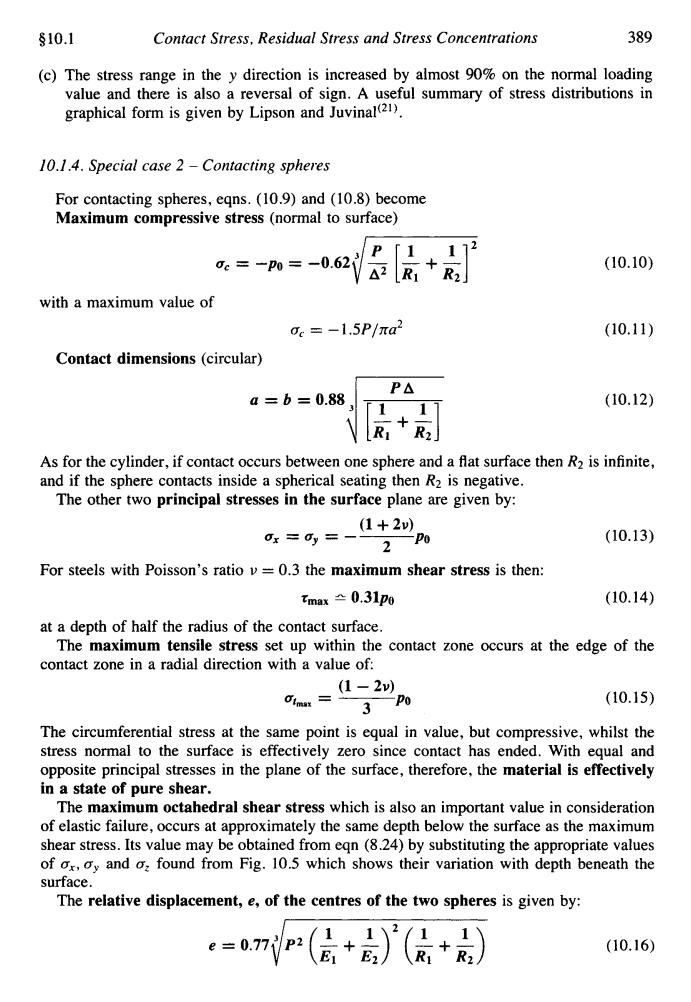正在加载图片...

§10.1 Contact Stress,Residual Stress and Stress Concentrations 389 (c)The stress range in the y direction is increased by almost 90%on the normal loading value and there is also a reversal of sign.A useful summary of stress distributions in graphical form is given by Lipson and Juvinal(21). 10.1.4.Special case 2-Contacting spheres For contacting spheres,eqns.(10.9)and (10.8)become Maximum compressive stress (normal to surface) P「1. 172 0c=-p0=-0.621 △2R1 +R2】 (10.10) with a maximum value of Oc =-1.5P/na2 (10.11) Contact dimensions (circular) P△ a=b=0.88 (10.12) 「1 11 As for the cylinder,if contact occurs between one sphere and a flat surface then R2 is infinite, and if the sphere contacts inside a spherical seating then R2 is negative. The other two principal stresses in the surface plane are given by: (1+2) 0x=0y= 2P (10.13) For steels with Poisson's ratio v=0.3 the maximum shear stress is then: tmax±0.31po (10.14) at a depth of half the radius of the contact surface. The maximum tensile stress set up within the contact zone occurs at the edge of the contact zone in a radial direction with a value of: (1-2) Utmax 3P0 (10.15) The circumferential stress at the same point is equal in value,but compressive,whilst the stress normal to the surface is effectively zero since contact has ended.With equal and opposite principal stresses in the plane of the surface,therefore,the material is effectively in a state of pure shear. The maximum octahedral shear stress which is also an important value in consideration of elastic failure,occurs at approximately the same depth below the surface as the maximum shear stress.Its value may be obtained from eqn(8.24)by substituting the appropriate values of ox,oy and o:found from Fig.10.5 which shows their variation with depth beneath the surface. The relative displacement,e,of the centres of the two spheres is given by: e=nP(G+)'(民+》 (10.16)510.1 Contact Stress, Residual Stress and Stress Concentrations 389 The stress range in the y direction is increased by almost 90% on the normal loading value and there is also a reversal of sign. A useful summary of stress distributions in graphical form is given by Lipson and Juvinal(21). 10.1.4. Special case 2 - Contacting spheres For contacting spheres, eqns. (10.9) and (10.8) become Maximum compressive stress (normal to surface) with a maximum value of a, = - 1.5~lna~ Contact dimensions (circular) a = b = O.8tl3 jE (10.10) (10.11) (10.12) As for the cylinder, if contact occurs between one sphere and a flat surface then R2 is infinite, and if the sphere contacts inside a spherical seating then R2 is negative. The other two principal stresses in the surface plane are given by: (1 + 2u) 2 a, = by = -___ Po (10.13) For steels with Poisson’s ratio v = 0.3 the maximum shear stress is then: tmax 10.31~0 (10.14) The maximum tensile stress set up within the contact zone occurs at the edge of the at a depth of half the radius of the contact surface. contact zone in a radial direction with a value of (1 - 2u) 3 utmax = ___ Po (10.15) The circumferential stress at the same point is equal in value, but compressive, whilst the stress normal to the surface is effectively zero since contact has ended. With equal and opposite principal stresses in the plane of the surface, therefore, the material is effectively in a state of pure shear. The maximum octahedral shear stress which is also an important value in consideration of elastic failure, occurs at approximately the same depth below the surface as the maximum shear stress. Its value may be obtained from eqn (8.24) by substituting the appropriate values of a,, a,, and a, found from Fig. 10.5 which shows their variation with depth beneath the surface. The relative displacement, e, of the centres of the two spheres is given by: e = 0.77 J P2 (i1 - + - iJ2(d+&) (10.16)